
Running caries is a complex pathology of damage to the teeth, resulting from the intensive demineralization of tooth enamel. This disease has other names: the term “multiple caries” is often found in medical practice, but others are applicable - “blooming”, “generalized”, “acute”, “systemic”.
In this form of the disease, the lesion from 5 to 20 teeth is characteristic, and in one tooth there are often several carious cavities. There is no unambiguous estimate of the number of affected teeth for diagnosing multiple forms of caries. As a rule, a diagnosis corresponding to generalized caries is made to children with KPU from 5 teeth or more and to adults with KPU from 6 teeth or more.
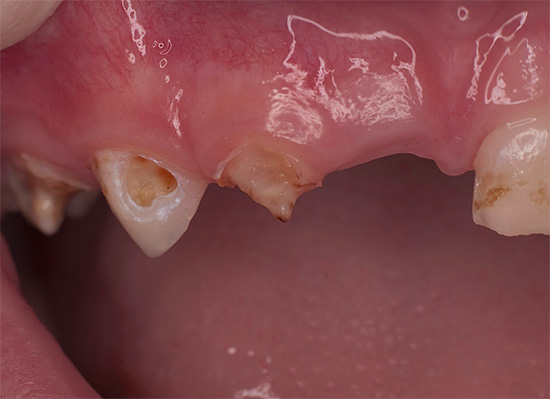
On a note
The KPU index is defined as the sum of the surfaces of the teeth that have carious lesions, sealed and removed.
Generalized caries is an acute disease characterized by intensive development. Serious infectious diseases, chronic diseases of the respiratory organs and weakening of the immune system can provoke it.
Today, due to the popularization of oral care and the availability of dental services, the disease has become less common, but the problem is still relevant in rural areas and in school-aged children, when almost all the teeth in a child are caries-affected (see the example in the photo) and parents don't know what to do in such a situation.

It is important to keep in mind that this problem requires the most careful attention, since the started caries can provoke the loss of the entire dentition.
Symptoms and clinical manifestations of generalized caries
Generalized caries is dangerous because it develops extremely fast. Sometimes most of the teeth are affected within one year.
Symptoms of the disease are obvious and can be identified by patients on their own. Visual inspection of the oral cavity causes caries on almost all teeth.and often there are several lesions in each tooth. In addition, the disease is accompanied by pain, there is an unpleasant smell from the mouth.
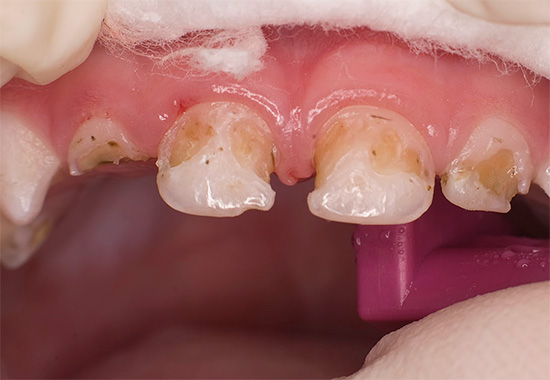
Clinical manifestations characteristic of multiple caries:
- simultaneous damage to a large number of teeth;
- slight damage to the enamel, along with extensive destruction of the dentin;
- the formation of cavities on different surfaces of one tooth;
- the appearance of lesions even in the immune zones and teeth that are most resistant to carious lesions - incisors and canines;
- painful contact with sour and sweet foods;
- the presence of a reaction to temperature stimuli;
- rapid formation of plaque;
- increased saliva viscosity;
- decrease in secretory IgA;
- painful sensing due to lack of replacement dentin;
- the presence of lesions at different stages of development - from the initial "white" caries to neglected periodontitis.
In patients with multiple caries, saliva is poor and very viscous. It badly cleans the teeth, which further aggravates the situation.
Important:
Oral fluid (saliva) acts as a natural cleaner of the oral cavity.In addition, it is also called "liquid enamel", since the return of the lost trace elements necessary for the formation of the structure of the enamel, is due to saliva. Sufficient salivation with high-quality mineral composition allows returning the maximum amount of lost minerals (fluorine, calcium, phosphorus, etc.). This is just one of the explanations that some people may not take care of their teeth, and, oddly enough, they do not collapse, or they collapse very slowly and slightly.
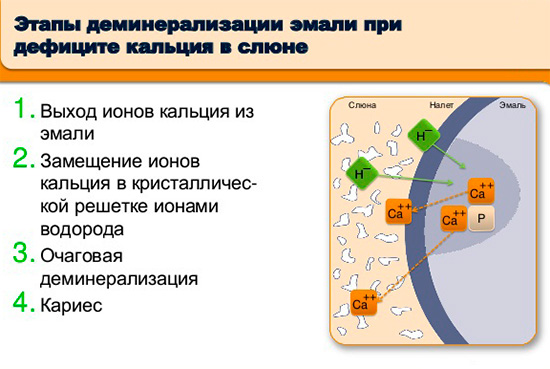
In case of generalized caries, fillings quickly fall out of the cured teeth; this often happens 1-2 months after their installation. This situation is explained by the fact that caries progresses under the fillings, causing softening of the tissues and weakening the fixation of fillings.
In addition to the fact that caries is dangerous to health, causes pain and restricts the choice of food, it is also a serious aesthetic problem. The photo below shows an example of generalized caries:

The disease can lead to the development of complexes: a person begins to smile less often, feels constant insecurity and discomfort, stops feeling attractive and closes. This is especially dangerous if it becomes the norm in childhood.
Why does this disease develop?
Graphically, the causes of caries are often depicted as a “trefoil Case” - a symbol consisting of three circles mutually overlapping in the center. This image gives an understanding that caries appears when three conditions coincide:
- cariogenic microflora develops on the surface of the teeth, the acid secretions of which destroy the tooth tissues;
- in the oral cavity most of the time there are easily digestible carbohydrates that serve as food for bacteria;
- for various reasons, from genetic to pathological, low enamel resistance develops.
All these factors actively contribute to the development of multiple caries.
Recently, the trefoil is often supplemented by the fourth circle, symbolizing the duration of the interaction.
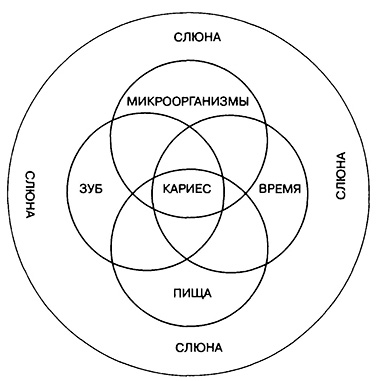
Common factors affecting the development of caries are:
- chemical composition of drinking water;
- diet;
- ecological situation;
- heredity;
- somatic diseases;
- inadequate oral hygiene (violation of hygiene rules).
The cause of the development of multiple caries in most cases is the general unsatisfactory condition of the patient. It is worth noting that quite often this disease occurs in children.
The photo below shows another example of running caries of milk teeth The child has:
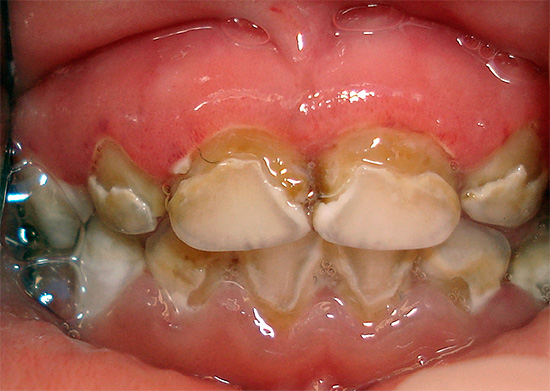

Most often, this situation is observed in children who have had acute infectious diseases, are suffering from various chronic diseases and have congenital heart defects.
High susceptibility to generalized caries is observed in children who have had angina, scarlet fever, suffering from chronic rheumatism, glomerulonephritis, Littl's disease, Down syndrome, marble disease.
Strong caries is also characteristic of children suffering from tuberculosis and having generally weak immunity. It is almost always found in people infected with HIV. Endocrine disorders and diabetes mellitus are also often causes of the development of acute caries.
Also at risk are adolescents, since during the hormonal adjustment this disease often progresses.
Survey results:
Surveys of schoolchildren in Russia show that the more a child has had an infectious disease, the more his teeth are affected by caries. Often in children with blooming caries chronic tonsillitis and adenoids are found. In many subjects, the antitoxic function of the liver is inhibited. Almost always the disease is associated with diseases of the central nervous system or the endocrine system.
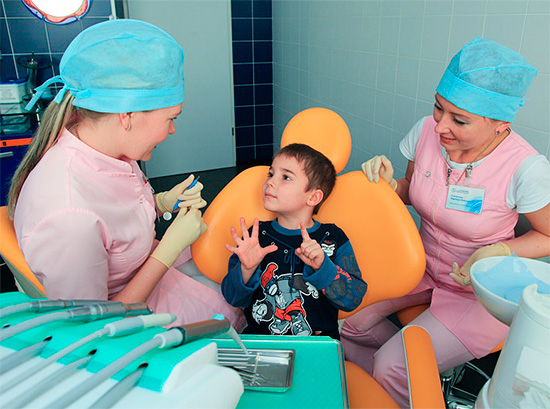
What if all the teeth are caries? First of all, you need to contact your dentist and pediatrician, you may also need the help of an endocrinologist and an immunologist. Multiple caries is a serious and dangerous disease, therefore it is necessary to approach the treatment responsibly and not to start the pathology for irreversible consequences.
Not only children suffer from blooming caries, the disease can also develop in an adult. Often this is due to the cessation of the functioning of the salivary glands, for example, as a result of radiation therapy of oncological diseases. The disease is so devastating that it sometimes leads to the destruction of the crown part of individual teeth within a few weeks after the onset of development.

There is a danger of damage in those suffering from gastroduodenal diseases, chronic neuro-somatic diseases, as well as those who have suffered acute infections.
Treatment of multiple caries
Early treatment of multiple caries is extremely necessary, regardless of whether the baby’s baby teeth or permanent teeth are affected. Also, do not think that the teeth fall out, and the problem itself will disappear.
What should parents do? First of all, it is necessary to contact a dental clinic, whose specialists will treat the affected teeth and refer the patient for an additional examination by other doctors.
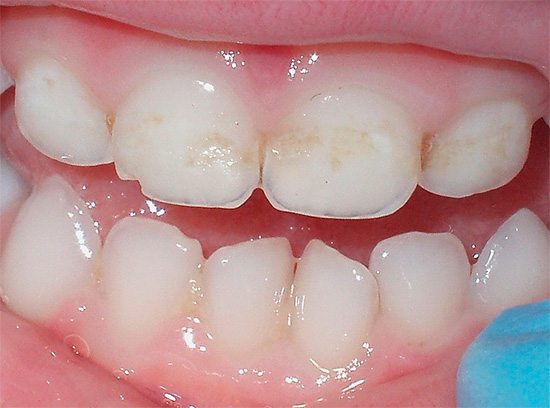
Local treatment involves:
- conducting anesthesia preparation;
- removal of damaged dentin;
- the formation of cavities and their treatment with antiseptic;
- silvering individual teeth;
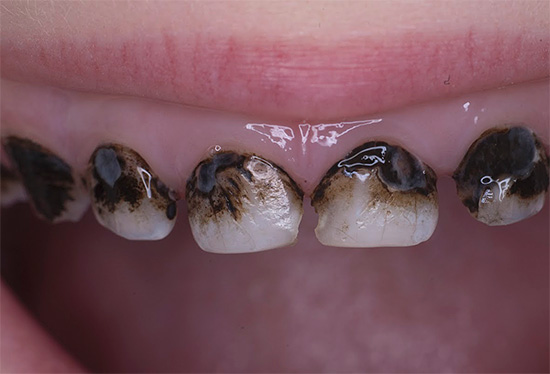
- the use of drugs that stimulate the production of replacement dentin in the tooth.
In especially advanced cases, depulpation, the installation of crowns, or even tooth extraction with subsequent prosthetics is required.
To effectively eliminate advanced caries, you will also need to identify and cure the disease that caused its development. Often, a medical examination of the patient is carried out, during which he is prescribed fortifying therapy, physiotherapy, taking vitamins and a specialized diet.
To restore the calcium-phosphorus balance and strengthen the immune system, the patient is prescribed calcium, phosphorus, fluorine and iron preparations, as well as vitamins A, B, C, D. Typically, treatment lasts several months, due to the slow normalization of mineral metabolism.
The diet is developed individually for each patient, taking into account the causes and nature of the disease. It necessarily includes foods rich in proteins, vitamins and mineral salts.
Physiotherapeutic procedures are very effective for generalized caries: calcination and fluoridation of teeth with the help of special preparations and (or) electrophoresis.
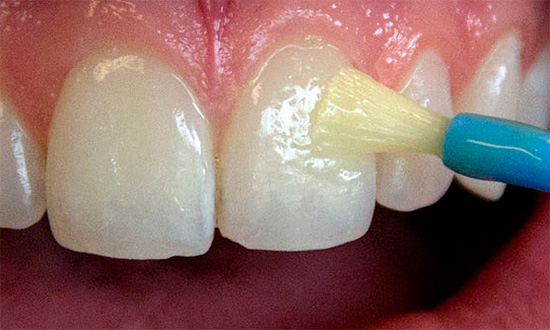
On a note
Children who have or have at the moment foci of multiple caries, must be in the dispensary and under observation. Sanitation (complex treatment) carious lesions of teeth accompanied by the implementation of therapeutic and preventive measures:
- Professional oral hygiene (cleansing of tartar and plaque).
- Training in oral hygiene of the parents of the child, the child himself with controlled brushing of teeth, control of brushing teeth during the period prescribed by the children's dentist.
- The mineralization of the teeth in the chair at the dentist with calcium and fluoride preparations with possible options for combining techniques to achieve the best result in each case (for example, with “Gluftored” for deep fluoridation).
- Treatment of inflammatory processes in the gums surrounding the teeth. Unfortunately, when the oral cavity is unsatisfactory, there are local or generalized lesions of the periodontal tissues (for example, gingivitis). If the inflammatory process in the gum was ignored, multiple infections in the tissues would provoke tooth decay. It is easy to understand: if the gum is swollen and painful, bleeds easily when touched, then neither the parents nor the child will be able to follow the instructions of the dentist to perform the correct techniques for cleaning the surfaces of the teeth, in particular in the cervical area,where the highest risk is the formation or progression of caries due to the presence of mild plaque.
Basic preventive measures
Prevention of generalized caries is aimed at the overall strengthening of the patient's health and increasing the resistance of the teeth to the development of this disease.

Important preventive measures are:
- a balanced diet that is mandatory contains dairy products and foods rich in vitamins;
- the use of easily digestible carbohydrates in limited quantities;
- timely treatment of somatic diseases;
- careful oral hygiene at least twice a day;
- the use of pastes, specially designed to combat tooth decay;
- regular toothbrush replacement.
This is the minimum, the fulfillment of which will help to preserve health and a beautiful smile for a long time. It is also important to have a regular check-up in the dental office, even if the teeth look completely healthy.
Interesting video: clearly shows how caries develops from the surface to the tooth root
Caries: from what teeth are destroyed
An example of caries treatment with a drill

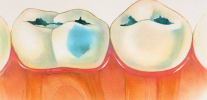
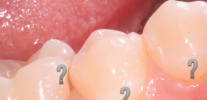

I have a tooth ache with caries, but not much whining, tolerable. I'm thinking, to seal it or not, or is it still so? Could it be that after treatment he gets more sick?
Of course, heal.Then it will be too late.
If there are caries and it bothers you, then you MUST be treated. Of course, it depends on the course of the disease (acute or chronic caries), but it’s definitely not worth leaving. Complications such as pulpitis can go, for example, when you want to climb pain from the pain. After pulpitis, periodical and then periodontitis will follow, which will bring new colors and a lot of unforgettable sensations into your life. In any case, you need to go to the dentist, he will tell you what to do in your situation. It is better to go to a proven dentist, because Nowadays, a sufficient number of "specialists" who can make it worse.
Good luck to you, do not tighten with treatment! Do not be afraid of the doctor, he is afraid of you no less 😉
Of course, heal! Today I went to the dentist, I have a hole in the tooth. Caries. I was cured of it, now the tooth does not hurt at all, only a slight pain remains from the injection. Rather treat, good luck!
My child is 2 years old. I have already been running through all dentistry for a year, but they say everywhere: wait for them to fall out. It began with the fact that a speck appeared on the upper tooth. Then there was a chip on the same tooth.And then it went and went, all nearby teeth began to marvel at caries. In the end, we now have a neglected stage. Everywhere they write that they need to be treated, and where? Only in Moscow? I, unfortunately, do not have this opportunity. Tell me where to go? We live in Armenia.
How are you doing? Cured teeth in a child?